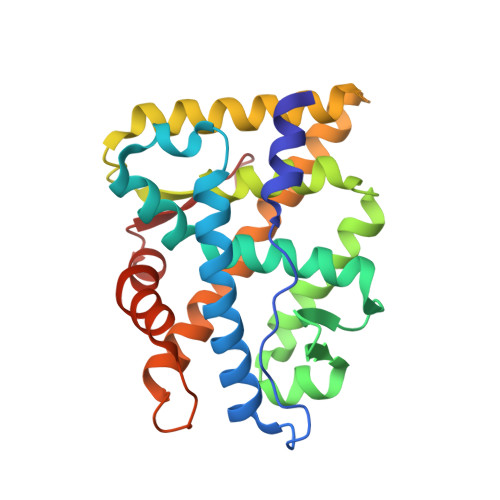A hotspot for posttranslational modifications on the androgen receptor dimer interface drives pathology and anti-androgen resistance.
Alegre-Marti, A., Jimenez-Panizo, A., Martinez-Tebar, A., Poulard, C., Peralta-Moreno, M.N., Abella, M., Anton, R., Chinas, M., Eckhard, U., Piulats, J.M., Rojas, A.M., Fernandez-Recio, J., Rubio-Martinez, J., Le Romancer, M., Aytes, A., Fuentes-Prior, P., Estebanez-Perpina, E.(2023) Sci Adv 9: eade2175-eade2175
- PubMed: 36921044
- DOI: https://doi.org/10.1126/sciadv.ade2175
- Primary Citation of Related Structures:
7ZTV, 7ZTX, 7ZTZ, 7ZU1, 7ZU2 - PubMed Abstract:
Mutations of the androgen receptor (AR) associated with prostate cancer and androgen insensitivity syndrome may profoundly influence its structure, protein interaction network, and binding to chromatin, resulting in altered transcription signatures and drug responses. Current structural information fails to explain the effect of pathological mutations on AR structure-function relationship. Here, we have thoroughly studied the effects of selected mutations that span the complete dimer interface of AR ligand-binding domain (AR-LBD) using x-ray crystallography in combination with in vitro, in silico, and cell-based assays. We show that these variants alter AR-dependent transcription and responses to anti-androgens by inducing a previously undescribed allosteric switch in the AR-LBD that increases exposure of a major methylation target, Arg 761 . We also corroborate the relevance of residues Arg 761 and Tyr 764 for AR dimerization and function. Together, our results reveal allosteric coupling of AR dimerization and posttranslational modifications as a disease mechanism with implications for precision medicine.
- Structural Biology of Nuclear Receptors, Department of Biochemistry and Molecular Biomedicine, Faculty of Biology, University of Barcelona (UB), 08028 Barcelona, Spain.
Organizational Affiliation:


















